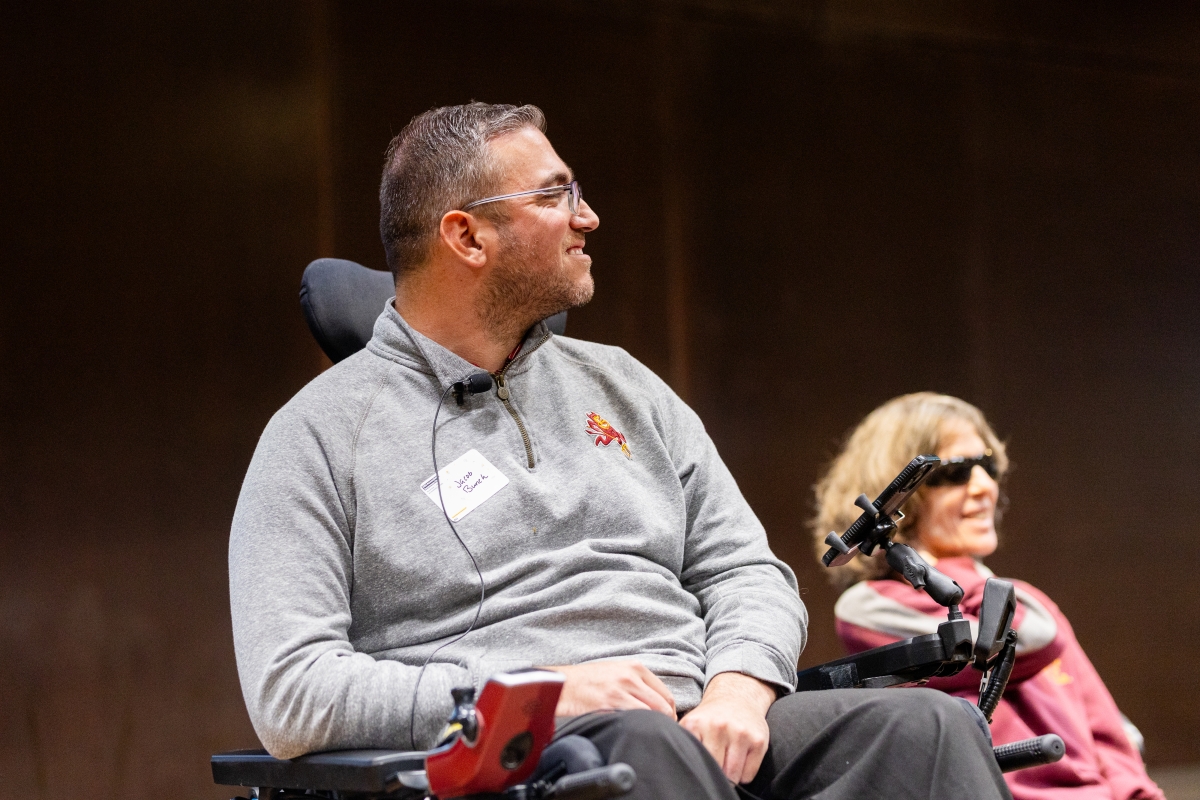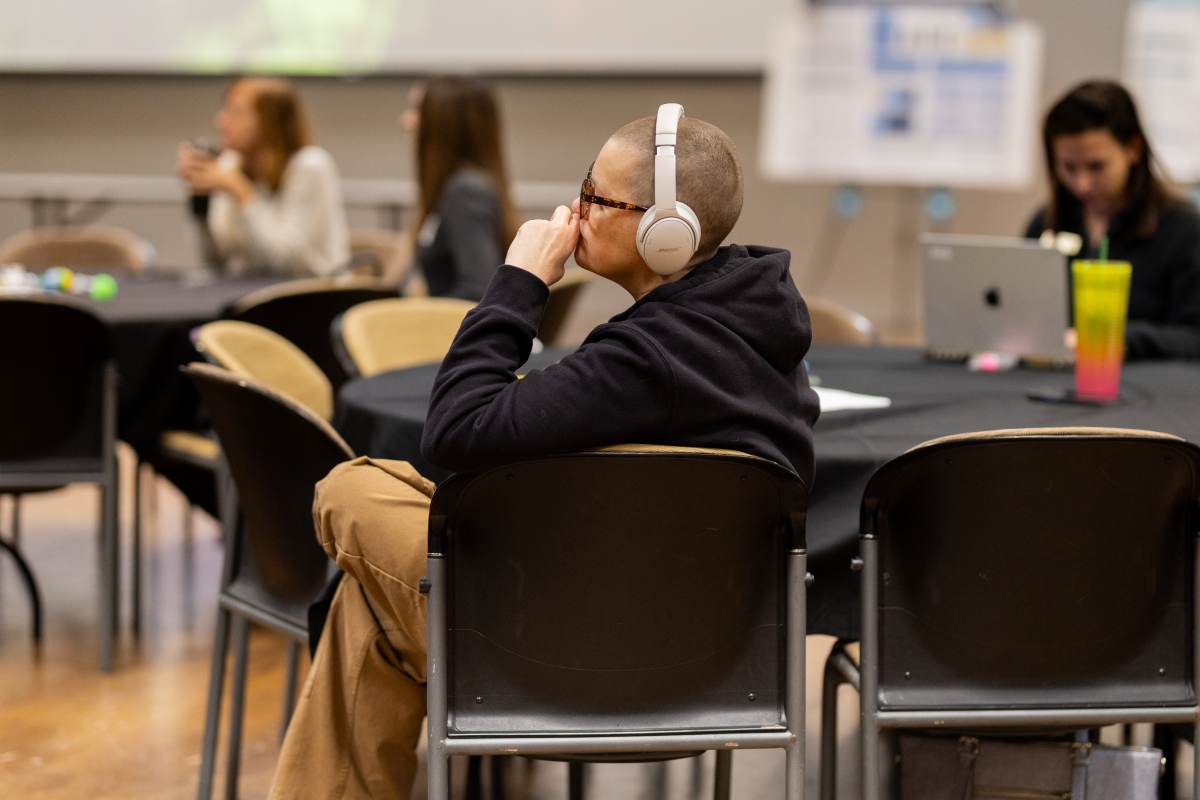ASU Accessibility Awareness Day advocates for a more inclusive digital future

Renowned digital inclusion strategist, author and instructor Belo Miguel Cipriani provided the featured keynote at this year's ASU Accessibility Awareness Day. Photo courtesy of ASU Enterprise Technology
By Jonathan Crowell
As technology continues to drive learning and research innovations, so do efforts to ensure digital products and environments are accessible by all.
Last week, Arizona State University hosted Accessibility Awareness Day, an annual event put together by the Universal Design and Accessible Technology Working Group. Nearly 750 individuals — including faculty, staff, students and community members — registered to attend in person or online.
Presentations covered topics such as web accessibility standards, assistive technology, personal experiences in the workplace, upcoming requirements for accessibility in digital spaces and inclusive design practices.
“Our intent is to keep the event focused on a growth mindset, and to expand people's perspectives,” said Krista Puruhito, an associate teaching professor at ASU’s T. Denny Sanford School of Social and Family Dynamics.
Puruhito co-chaired this year’s event alongside Mary Loder, who works as the manager of professional development and training with EdPlus at ASU. Both Puruhito and Loder expressed the importance of an enterprise-wide effort to ensure all corners of the university are involved.
“Accessible design affects everyone,” Loder said.
Puruhito agreed, noting that her students — both with and without disabilities — benefit from more accessible design techniques. “A rising tide lifts all boats,” Puruhito said.
Shared experiences and common goals
Common universal design web accessibility features include alternative text (alt-text) for images, captions for audio and video content and compatibility with screen readers. However, according to recent data, over 96% of homepages failed to meet the standards set by governing bodies.
“Much of universal design for learning principles are foundationally based on accessible design,” Loder said. “Having a universal design mentality benefits everyone, and we all shoulder the responsibility to meet people in the way they succeed, not just in the way we think they might.”
Loder added that it is important not to lose sight of the fact that, for many individuals, the ability to access meaningful learning experiences is dependent on a universal design mentality. And those individuals include, but are not limited to, those with visual and hearing impairment, learning disabilities and even those with diverse learning styles.
“While this conference is enhancing accessibility, it is also about centering the voices of people who have disabilities,” Loder said.
Session spotlights
One highlight of this year’s event was the opening keynote address by Belo Miguel Cipriani, a renowned digital inclusion strategist, author and instructor. Cipriani, who is visually impaired, shared his personal journey and insights into the importance of accessibility for all.
“Compliance (with mandated accessibility regulations) meets just the very bare minimums,” he said, adding that he hopes to see a paradigm shift toward a mentality that embraces a more inherently accessible digital landscape for everyone.
“Accessibility, like writing, is a skill that anyone can choose to develop. ... Ideally, those who master this skill will not just become users, but also producers and content creators.”
Legal requirements and ASU’s strategy for compliance
The session "The ADA’s New Digital Accessibility Regulations: Legal Overview & How ASU Is Implementing" focused on new technical standards for digital accessibility under Title II of the Americans with Disabilities Act (ADA). The discussion was led by Enterprise Technology’s Itzel Morales Lizarraga, director of web and user experience, and Chelsea Sage Gaberdiel, from the ASU Office of General Counsel and faculty associate with the Sandra Day O'Connor College of Law.
Gaberdiel and Morales Lizarraga provided a legal overview of new upcoming digital accessibility regulations for websites and mobile applicationsWCAG 2.1 AA standards. Morales Lizarraga shared her team’s approach: "We want to make accessibility part of our culture at ASU, integrated within our workflows, our processes and our activities.”
With an implementation deadline of April 2026, the two presenters noted that ASU is actively working to address these requirements, including conducting audits, developing training programs and implementing technical solutions.
Gaps to address
A panel discussion titled "Disability Lasts Beyond Graduation: From Student to Employee" highlighted the ongoing challenges faced by individuals with disabilities in academia. Panelists Sarah Bolmarcich, Terri and Montreux Hlava, Jacob Bunch and Jordan Claire shared personal experiences of discrimination, miscommunication and inaccessible environments, emphasizing the need for increased awareness, support and systemic change.
One key issue that surfaced during the discussion was the importance of self-advocacy and disclosure. Panelists stressed the need for individuals with disabilities to assert their needs and advocate for accommodations, while also acknowledging the potential risks and challenges associated with disclosure.
Making the learning experience more accessible
In one of the final sessions, presenters Courtney Ellsworth and Kyle Wagner of the Mary Lou Fulton Teachers College shared details of a course titled "Empowering Learners through Universal Design." The course aims to equip faculty with the knowledge and skills to apply Universal Design for Learning (UDL) principles to their teaching practices.
UDL is an educational framework that focuses on creating flexible learning environments that meet the needs of diverse learners. By incorporating UDL principles, instructors can design courses that are accessible to all students, regardless of their abilities or learning styles.
“We believe that exercising an equitable, inclusive and thoughtful approach to instruction, not only benefits students but positions you as a forward-thinking faculty member," Ellsworth said.
The course, which is available to all ASU faculty, covers a range of topics, including UDL basics, identifying barriers to learning, designing inclusive assessments and using technology to enhance accessibility.
More Sun Devil community

A symphony of service: Iraq War vet and ASU alum finds healing through music
At the age of 30 and only one credit away from obtaining his bachelor’s degree in piano performance, Jason Phillips could no longer stifle the feeling that he was stuck. He was teaching at a…

ASU first-gen college student is a leader in sustainability, social justice
Born and raised in Phoenix in a single-parent household, Mauricio Juarez Leon faced struggles growing up that included poverty, malnutrition, domestic abuse and limited resource access. And at the…

These real-life heroes found educational support through ASU Online
When “God Bless America” played at Dani Bermudez’s naturalization ceremony, the moment gave her chills and cemented her resolve to one day serve in the military.The Colombia native enlisted in the…




